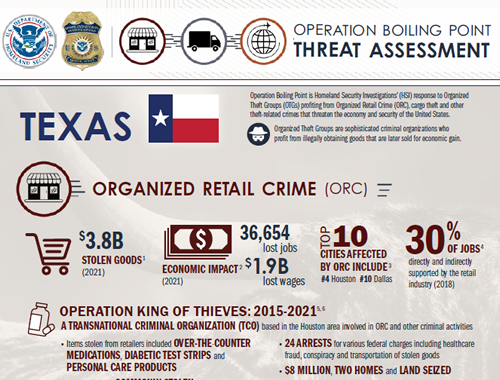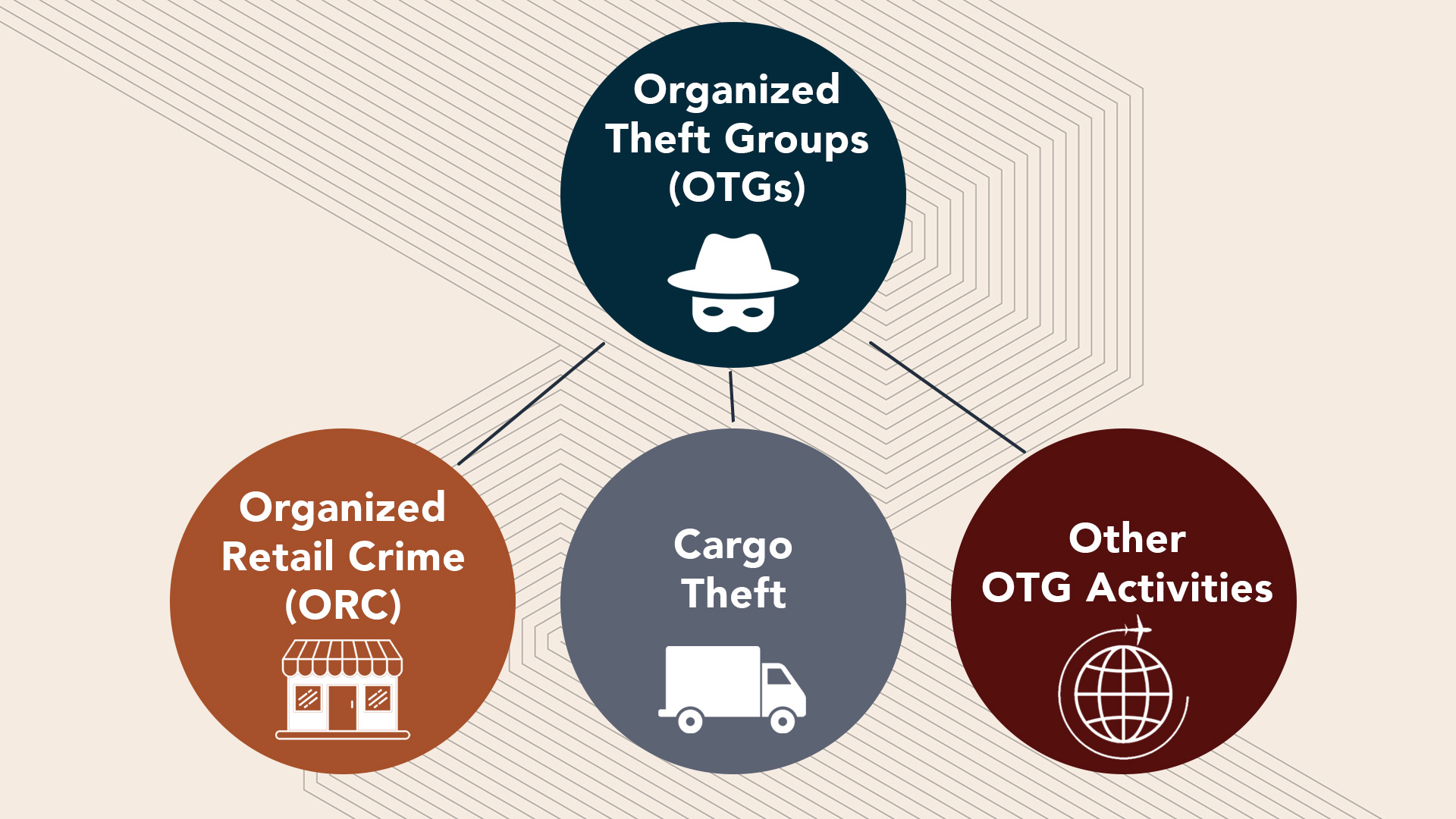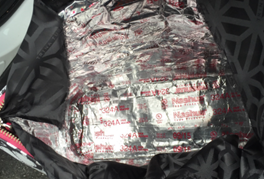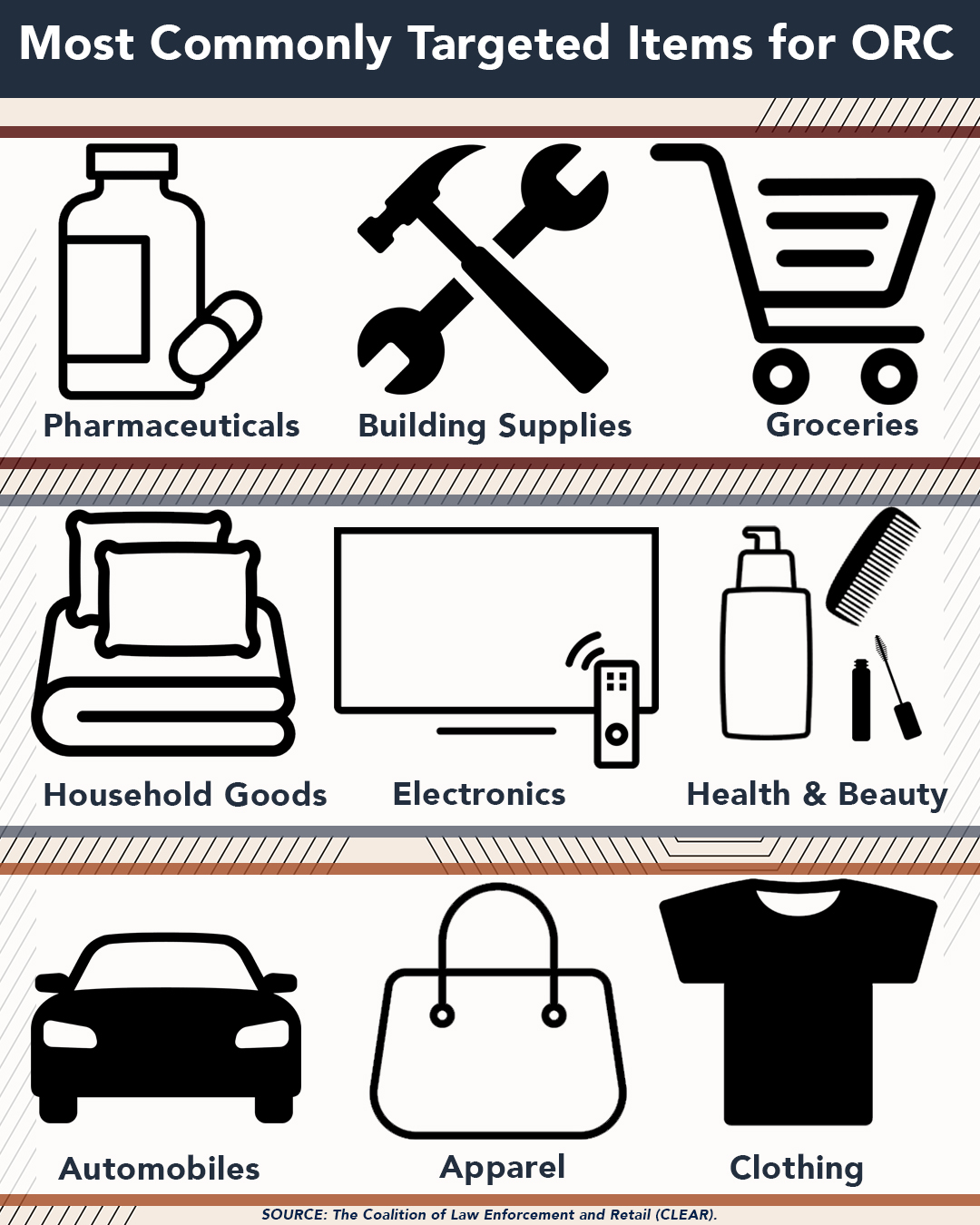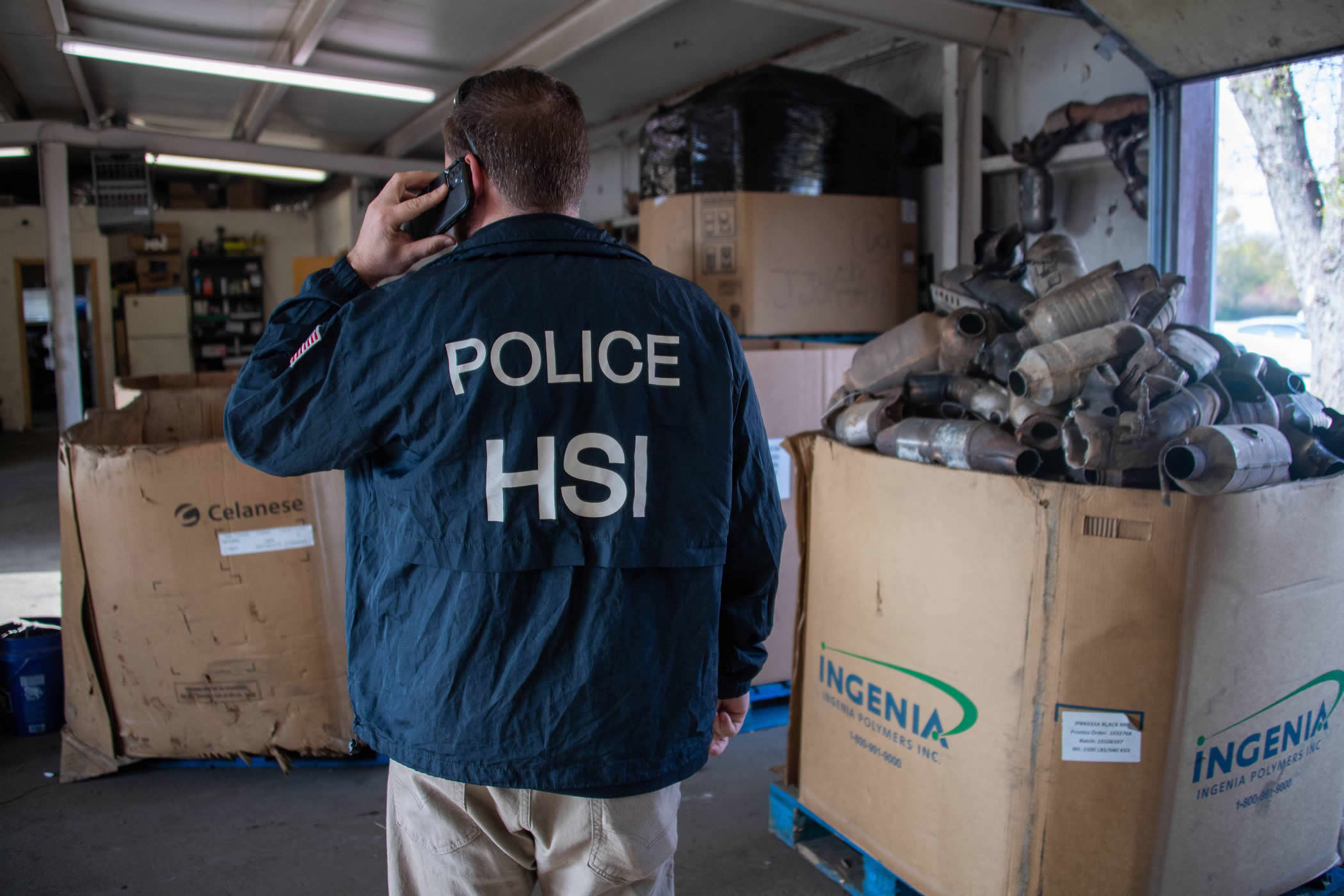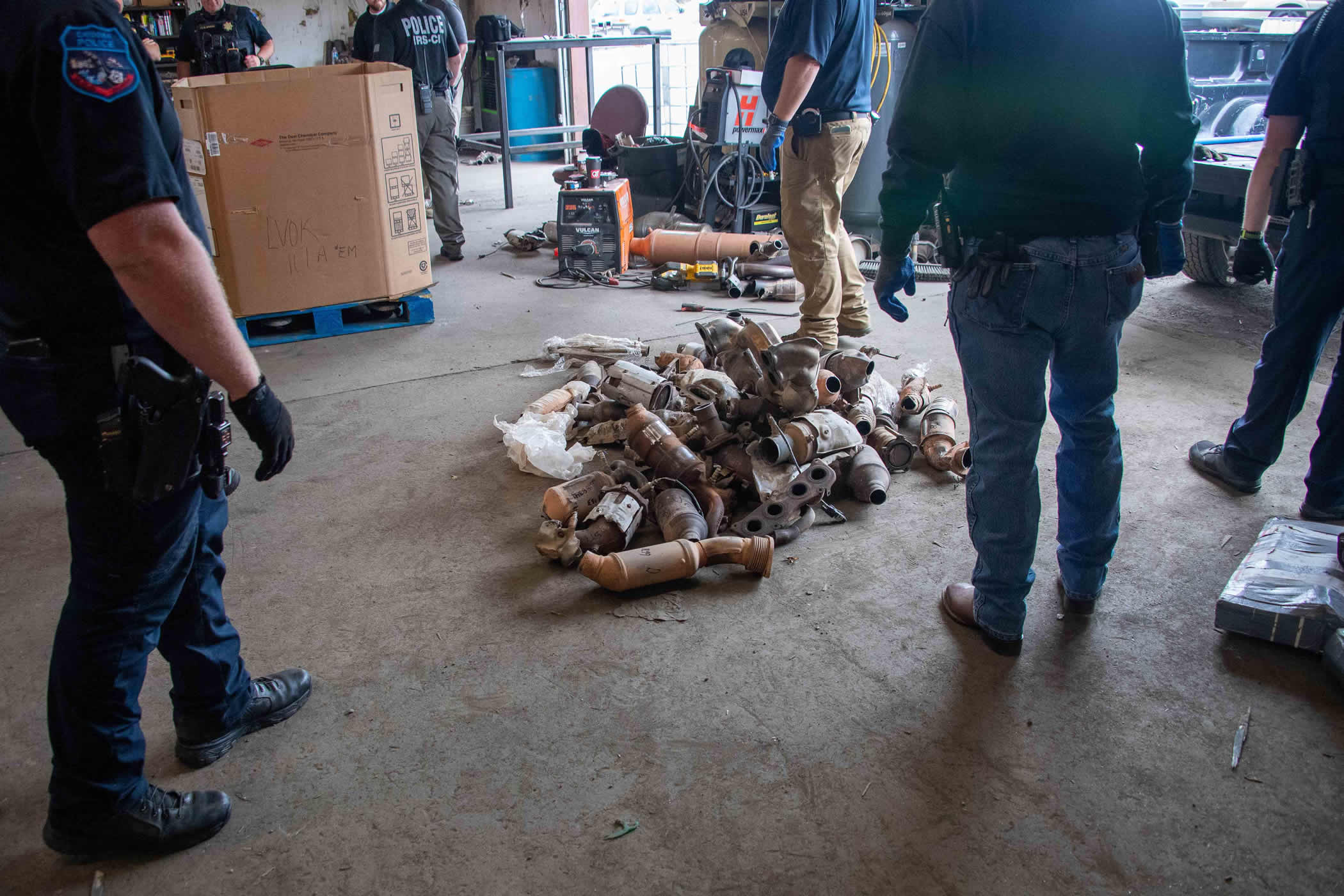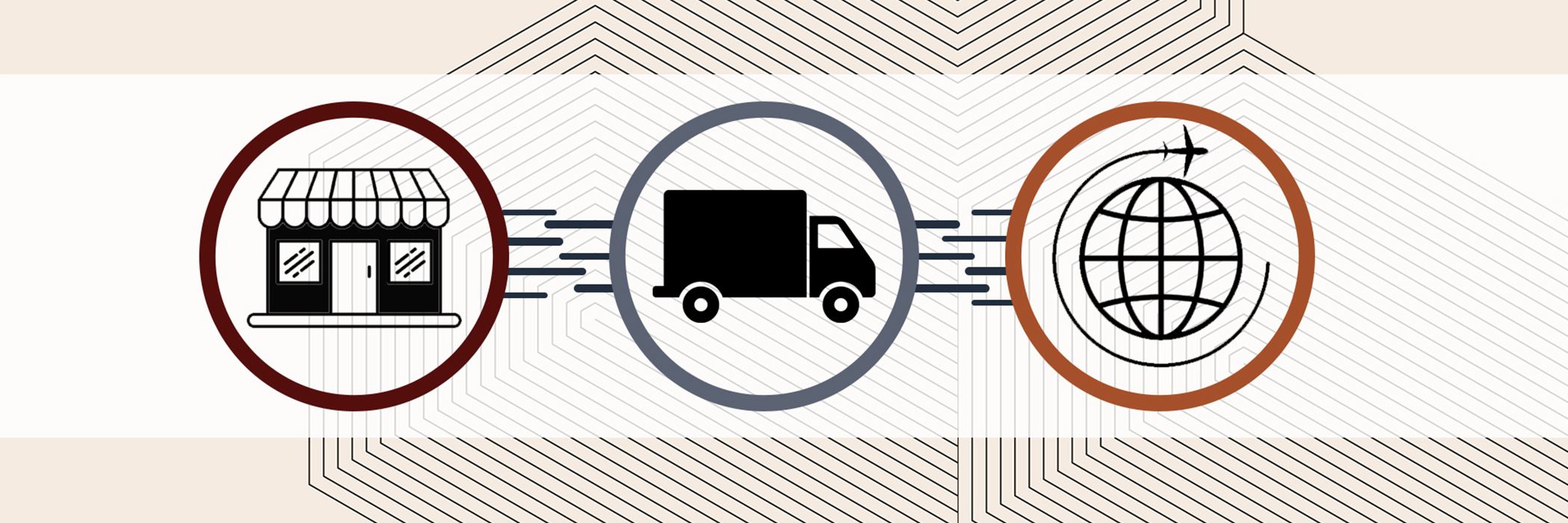
Subscribe to receive updates via email
Organized Theft Groups
Organized Theft Groups (OTGs) are sophisticated criminal organizations that profit from illegally obtaining goods that are later sold for economic gain. OTGs are known to profit from Organized Retail Crime (ORC), cargo theft, and other theft and fraud-related criminal activities. OTGs can be involved in a myriad of other crimes including, but not limited to narcotics trafficking, human trafficking, money laundering, and even terrorism. It is important to understand that this criminal activity is Organized Crime.
Organized Retail Crime
Homeland Security Investigations (HSI) defines ORC as “the association of two or more persons engaged in illegally obtaining items of value from retail establishments, through theft and/or fraud, as part of a criminal enterprise.”
According to the 2021 joint report released by the Retail Industry Leaders Association (RILA) and the Buy Safe America Coalition, in 2019, nearly $70 billion in goods were stolen from retailers. As staggering as this number is, it doesn’t account for loss related to cargo theft nor the uptick in ORC during the COVID-19 pandemic.
ORC is not shoplifting, and these crimes are not victimless. In addition to the growing number of thefts that turn violent, consumers, local communities and businesses bear the costs of rising prices. These thefts are detrimental to both businesses, small and large alike, and the overall economy as they pose both societal and health risks to the community.
Estimates reveal ORC costs federal and state governments nearly $15 billion in lost tax revenue, not including lost sales taxes. It is estimated that the average American family will pay more than $500 annually in additional costs due to the impact of ORC. ORC is a low-risk, high-reward income stream for domestic and transnational criminal organizations that greatly impacts inter-state and international commerce and the overall economic security of the United States.
“Organized retail crime is leading to more brazen and more violent attacks in retail stores throughout the country and many of the criminal rings orchestrating these thefts are also involved in other serious criminal activity,” said HSI’s acting executive associate director Steve Francis. “Tackling this growing threat is important to the safety of store employees, customers, and communities across the country.” Read the Jun. 1, 2022 News Release
What are Organized Retail Crime and Organized Theft Groups?
In this first of a four-part series, Homeland Security Investigations Countering Transnational Organized Crime Division Deputy Assistant Director Raul Aguilar defines Organized Retail Crime and Organized Theft Groups and how transnational criminal organizations profit from consumer “bargains” online. It’s not just shoplifting.
Why Should Consumers Care about Organized Retail Crime and Organized Theft Groups?
In this second of a four part series, Homeland Security Investigations Countering Transnational Organized Crime Division Deputy Assistant Director Raul Aguilar explains how Organized Retail Crime and Organized Theft Groups raise everyday costs for consumers, cost jobs and employee benefits, drain community tax revenue and threaten the safety of employees, consumers and members of the community.
What is the International Impact of Organized Retail Crime and Organized Theft Groups?
In this third of a four part series, Homeland Security Investigations Countering Transnational Organized Crime Division Deputy Assistant Director Raul Aguilar explains how sophisticated transnational criminal networks use profits from online sales of stolen merchandise to fund their criminal activity back in the U.S. He also discusses how Operation Boiling Point specifically targets these organizations using HSI’s vast, international authorities and partnerships.
Why should law enforcement agencies partner with Homeland Security Investigations to stop Organized Retail Crime and Organized Theft Groups?
In this fourth of a four part series, Homeland Security Investigations Countering Transnational Organized Crime Division Deputy Assistant Director Raul Aguilar encourages local, state and international law enforcement agencies and prosecutors to join the Operation Boiling Point team and take advantage of its national and international presence to stop Organized Retail Crime and Organized Theft Groups.
What is Operation Boiling Point?
Operation Boiling Point is Homeland Security Investigations' (HSI) response to OTGs profiting from ORC, cargo theft and other theft-related crimes that threaten the economy and security of the United States. HSI’s strong partnership with private industry groups, such as the Coalition of Law Enforcement and Retail (CLEAR), the National Retail Federation (NRF), the Retail Industry Leaders Association (RILA), the Transported Asset Protection Association (TAPA) and others, are critical to our efforts to combat OTGs who seek to disrupt interstate and foreign commerce.
The HSI Financial Crimes Unit (FCU) leads HSI’s effort to combat OTGs by targeting domestic and transnational criminal organizations that profit from ORC, cargo theft and related crimes. HSI focused on building and furthering partnerships to advance this national program by supporting investigations, conducting outreach and coordinating with public and private sector partners. Throughout the United States and abroad, HSI has approximately 7,100 special agents and relies on task force officers from federal, state, and local law enforcement agencies to combat transnational criminal organizations.
OTGs at Work
Unlike shoplifting, where an individual steals food due to hunger or related incidents of simple theft, OTGs illegally profit from systematically targeting retail establishments utilizing professional thieves known as “boosters.” Often, boosters travel in crews throughout the country utilizing aliases, rental vehicles, and tools such as “booster bags” and illegally acquired security keys to steal high-value merchandise.
Although some boosters may sell the stolen goods on their own, most of the time the stolen items are being sold to a middleman known as a “fence or fencer.” The fence/fencer purchases the stolen merchandise from boosters at a fraction of the retail value and will utilize several avenues to sell the stolen goods, e.g., e-commerce websites, social media, or wholesale/trading/distribution companies. Often, the fence/fencer, attempts to make the items appear legitimately obtained. For instance, utilizing lighter fluid and heat guns, the fencing operation will remove retailer anti-theft stickers from commonly stolen goods making them appear clean and to avoid suspicions. The stolen items are then reintroduced to the supply chain by one of the methods listed above. Further, other OTGs utilize freight forwarding companies to send stolen goods overseas.
Cargo Theft
It is estimated that cargo theft accounts for $15-35 billion in loss annually. OTGs target cargo at the ports of entry, at truck stops, on freight trains, and anywhere else along the supply chain as the goods are in transit. OTGs utilize a variety of means to steal cargo including fraudulent pick-ups, phony documentation, etc. Much of the cargo that targeted is destined for retailers and/or distribution centers. Although OTGs targeting cargo are not necessarily involved in ORC, they can be linked to common fences/fencers that are purchasing the stolen goods.
Commonly stolen items include, but are not limited to:
- Pharmaceuticals
- Electronics
- Personal care
- Clothing
- Food & Beverage
- Building Supplies
- Alcohol/Tobacco
The OTGs targeting cargo can be found throughout the U.S. However, much of the activity is in or around major hubs within the supply chain, including: Los Angeles, CA; , Dallas, TX; Memphis, TN; Chicago, IL; Atlanta, GA; and many other locations.
Other OTG Activities
OTGs are also involved in many other illicit schemes involving theft. Most recently, OTGs throughout the United States have been targeting vehicles for their catalytic converters, which contain high-value precious metals such as platinum, palladium, and rhodium. The OTGs, many of them employing or being led by gang members that are known to be violent, steal catalytic converters to sell to fences/fencers, which attempt to resell, refine, or export them for profit. This has created a worldwide supply shortage, increased demand, and has driven the prices for catalytic converters up in value. There are many OTGs involved in auto thefts, wheel thefts, and other similar crimes.
What You Need to Know
Consumers
- ORC is crime that involves OTGs. These groups are transnational criminal networks of individuals working in unison to steal for profit to finance their on-going operations and other criminal activity, such as labor, arms and drug trafficking. ORC is not shoplifting.
- OTGs focus on high-value branded items that are in demand from consumers, most of whom are unaware that they are purchasing stolen goods.
- ORC has been responsible for nearly $70 billion in retail merchandise being stolen from businesses in 2019.
- Cargo theft is estimated to be in the range of $15-30 billion per year.
- Losses resulting from ORC represent a distinct risk to the United States’ economic infrastructure. Broad immigration and customs authorities enable HSI to pursue complex banking and financial fraud cases to identify, dismantle and disrupt the criminal enterprises that threaten the nation’s economy and homeland security.
- ORC is often undertaken by local gangs or organized groups of individuals taking advantage for a quick profit.
- A common misconception is that retailers are insured against retail crime. Most retailers are self- insured, which means that retailers either take on these losses as operating costs and/or pass the impact on to consumers in the form of increased prices, lower wages and fewer staff.
- ORC is considered a property crime and often is a lower priority when cases are investigated and prosecuted.
- Estimates reveal retail theft costs federal and state governments nearly $15 billion in lost tax revenues, not including the lost sales taxes.
- It is estimated that the average American family will pay more than $500 annually in additional costs due to the impact of ORC.
Law Enforcement Organizations
- ORC is a low-risk, high-reward operation for transnational criminal organizations known as OTGs. These are transnational criminal networks of individuals work together to steal for profit. These illicit gains allow their ongoing operation to continue as well as fund other criminal activities, such as drug trafficking and human smuggling.
- Public perception of this criminal activity is that it is shoplifting. ORC is increasingly violent and surpasses the “smash and grab” thefts often covered in the news.
- Currently, no federal laws directly target ORC. This means prosecution is difficult when the crimes are typically multi-jurisdictional and multi-state.
- In FY 20, the average retail robbery netted more than $7,500. These amounts have not been seen since 2015.
Private Industry and Related Organizations
- OTGs plan thefts of highly sought-after goods and then sell them either through backdoor and online marketplaces or, in many cases, through apparently legitimate business fronts operating in plain sight.
- Different from burglary and shoplifting, ORC is part of an organized scheme with multiple participants working to defraud retailers or steal products for resale elsewhere.
- OTGs will focus on high-value items like leather goods, over-the-counter medications, health and beauty products, designer clothing and power tools.
- Common retailers targeted by OTGs include pharmacies, big box retailers, home improvement stores, grocery stores and clothing merchants.
- The National Retail Federation 2021 Retail Security Survey found that approximately 69% of retailers said they had seen an increase in ORC over the past year. In this survey, retailers cited COVID-19, policing, changes to sentencing guidelines and the growth of online marketplaces for the increase in ORC activity.
- Approximately 65% of respondents noted the increase in violence, while 37% said ORC groups were much more aggressive than in the past. For comparison, in 2019, only 57% said ORC gangs were more aggressive with 31% saying they were much more aggressive.
- Per the 2021 Retail Security Survey conducted by the National Retail Federation, in FY 20, the average retail robbery netted more than $7,500. These amounts have not been seen since 2015.
Elected Officials and Government Organizations
- According to the Washington ORC Association (WAORCA), ORC is defined as “the theft/fraud activity conducted with the intent to convert illegally obtained merchandise, cargo, cash, or cash equivalent into financial gain (no personal use), where/when the following elements are present: occurs over multiple occurrences, and/or in multiple stores, and/or in multiple jurisdictions, conducted by two or more persons or an individual acting in dual roles (booster & fence).”
- Currently, no federal laws directly target ORC. This means prosecution is difficult when the crimes are typically multi-jurisdictional and multi-state.
- ORC is not a victimless crime. Thefts can be violent, and sales associates have been threatened with weapons.
- Many ORC groups fund other criminal activities, such as labor, arms and drug trafficking with their ill-gotten gains in addition to defrauding retailers, threatening employees, reducing choice and increasing consumer costs.
- In addition to the increased ease of selling stolen goods through online and third-party platforms, the U.S. has begun raising felony thresholds for theft making these cases more difficult to prosecute.
- ORC has vast economic costs to the global economy and exploits the formal financial system.
- On the state and local level, ORC results in lost tax revenues, negatively impact the retail industry and leads to higher prices for goods and services.
HSI partners with others to combat ORC
At home and abroad, HSI embraces partnerships to strengthen its efforts to combat transnational crime, including ORC. Through various centers and task forces, HSI collaborates with law enforcement agencies, non-governmental organizations, and private industry to coordinate operations, generate leads, identify, rescue and support victims of crime, and prevent threats to the homeland. At a national level, HSI partners with many organizations representing thousands of businesses involved in the U.S. supply chain, including:
- National Intellectual Property Rights Coordination Center – coordinates a unified U.S. government response to the growing threat of counterfeiting and exploitation of e-commerce
- HSI Cyber Crimes Center – coordinates investigations of cyber-related criminal activity and provides various support services
- HSI Innovation Lab – develops new, advanced analytics capabilities, tools and enhanced business processes for HSI
- HSI International Operations – develops and supports investigations, initiatives and operations conducted or supported by HSI attaché offices and builds relationships with foreign law enforcement partners to support domestic cases, combat transnational criminal organizations and prevent terrorist activities
- International Organized Crime Intelligence and Operations Center – created from the Attorney General’s Organized Crime Council member agencies to provide support to investigations targeting multi-faceted transnational organized crime
- National Coalition of Law Enforcement and Retail (CLEAR)
- Retail Industry Leaders Association (RILA)
- Association of Certified Anti-Money Laundering Specialists (ACAMS)
- National Retail Federation
- Transported Asset Protection Association
HSI has also established strong partnerships with many eCommerce platforms related to information-sharing and targeting OTGs selling illicit goods via their websites.
Learn how retailers and financial institutions can partner with HSI
Retailers and other interested organizations can contact HSI through HSI Cornerstone Program representatives at HSI domestic field offices or Cornerstone@ice.dhs.gov.
Success Stories
Resources
The report – Detecting and Reporting the Illicit Financial Flows Tied to Organized Theft Groups and Organized Retail Crime – highlights red flags associated with organized theft groups, including structured deposits and withdrawals, large purchases of stored-value cards, high-dollar wire transfers tied to wholesale companies involved with health and beauty supplies, and large purchases of lighter fluid or heat guns, among others.
How You Can Help
Report suspicious activity
Members of the public can report suspicious activity, including organized retail crime, by calling the toll-free tip line at 866-347-2423, 24 hours a day, 7 days a week, every day of the year, or reporting it online at the HSI Tip Line.
Request More Information
Request a briefing or additional for your organization by contacting your local community resource officer.
Stay Informed
Sign up to receive current news and information about Operation Boiling Point and organized theft groups.

OBP Threat Assessment and Impacts per State
-
California
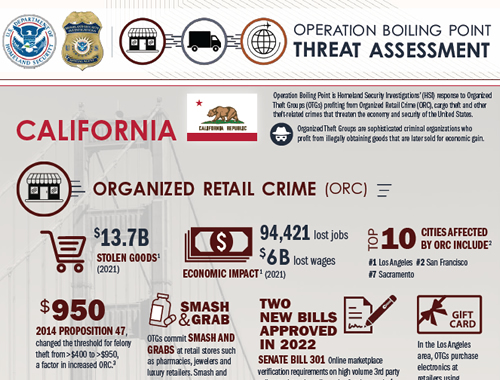
-
Florida
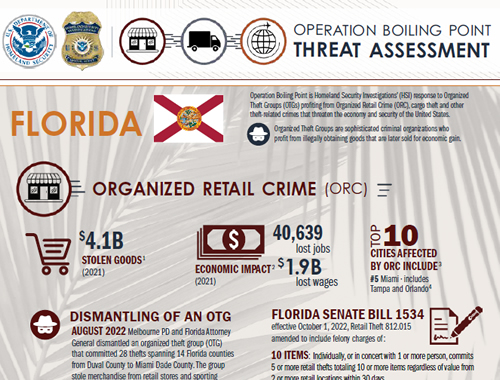
-
Illinois

-
New York
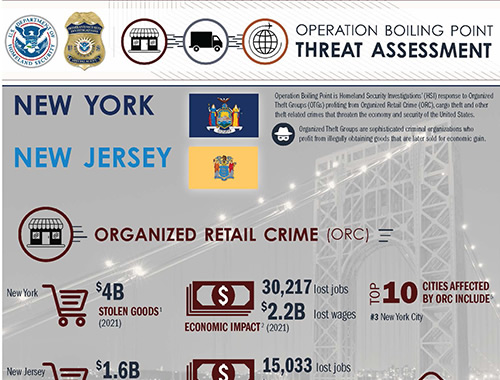
-
Texas
